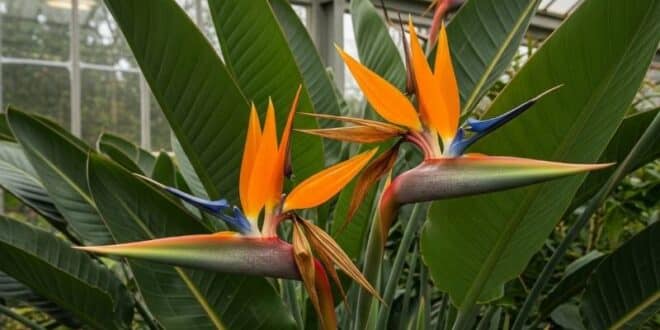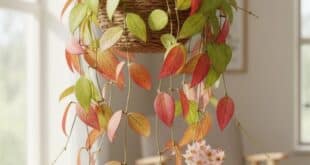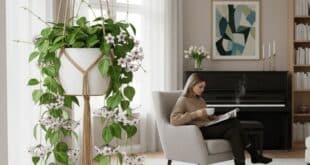Let’s Meet Bird of Paradise Plant
Imagine a plant that boasts flowers so breathtaking, they look exactly like a vibrant, exotic bird taking flight right in your living room! That’s the incredible Bird of Paradise plant! This magnificent beauty (Strelitzia reginae and Strelitzia nicolai are the most common types) is a true showstopper, instantly transforming any space into a lush, tropical paradise.
Hailing from the sunny coasts of South Africa, the Bird of Paradise is cherished for its unique, colorful blooms and its bold, banana-like leaves. It’s a plant that brings drama, elegance, and a hint of the extraordinary to any space. Ready to bring this majestic, living sculpture into your home? Let’s explore everything you need to know to make your Bird of Paradise truly flourish!
What Makes a Bird of Paradise Plant So Unique? Its Iconic “Bird-Head” Blooms and Bold Leaves
When you look at a Bird of Paradise, its flowers are undeniably the star of the show. They have such a unique, intricate shape – truly resembling a bird’s head and beak, complete with a crest of colorful petals! For the classic Strelitzia reginae, the flowers showcase a stunning combination of fiery orange and vivid blue, emerging from a robust, boat-shaped purplish-green “bract.” In contrast, the larger Strelitzia nicolai, often referred to as the Giant Bird of Paradise, features striking white and blue flowers, adding an impressive tropical flair. beautiful white and blue flowers.
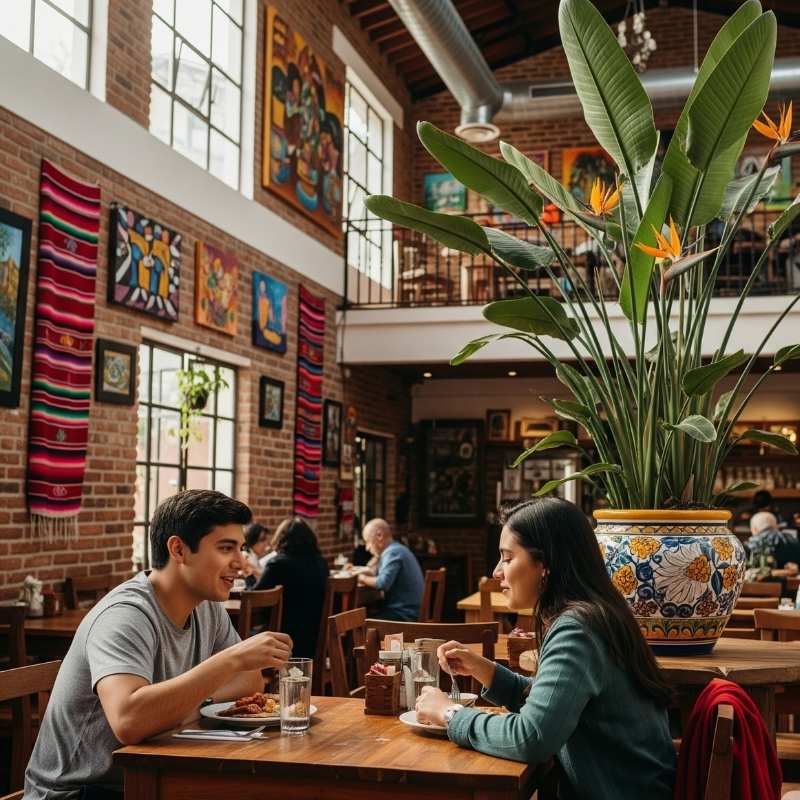
Even without blooms, the plant’s leaves are incredibly striking. They are large, paddle-shaped, glossy, and a rich dark green, looking very similar to banana leaves. These flowers stand tall and proud, giving the plant a striking, bold, and architectural presence that commands attention.
💡 Great spot for an image! You could add a stunning photo here of a classic Strelitzia reginae bloom, showing its “bird head” shape and vibrant colors.
Where Do Bird of Paradise Plants Come From? South Africa’s Sunny Coasts
Your Bird of Paradise plant’s ancestors come from the sunny, coastal regions of South Africa. In their natural habitat, they thrive in bright, open areas, often near riverbanks or in clearings, soaking up plenty of sunshine and enjoying warm temperatures. This background explains why they absolutely love bright light and warmth in our homes – it’s what makes them happiest and encourages those amazing blooms!
What Are Its Other Names? “Crane Flower” and Its Royal Charm
The most common nickname for the Bird of Paradise is “Crane Flower,” which also perfectly describes how its bloom resembles a crane’s head. The scientific name, Strelitzia, was given in honor of Queen Charlotte of Mecklenburg-Strelitz, the wife of King George III, adding a touch of royal charm to this already magnificent plant!
What Kinds of Bird of Paradise Plants Are There?
While the entire Strelitzia genus only has about five species, two types of Bird of Paradise plants are most commonly grown and loved indoors, each with its own unique appeal.
Popular Bird of Paradise Types: From Classic Orange to Giant White
| Type of Bird of Paradise | Key Features & Bloom Colors | Typical Indoor Size | Looks Like… |
| Strelitzia reginae | The classic! Bright orange and blue flowers, a smaller stature, and the iconic “bird head” shape define the classic Strelitzia reginae. | 3-6 feet tall (1-2 m) | The quintessential “Bird of Paradise,” often featured on postcards, is none other than the iconic Strelitzia reginae, celebrated for its vibrant colors and unique bird-like blooms.. |
| Strelitzia nicolai | Giant! Larger leaves (banana-like), white and blue flowers. Can become very tree-like. | 6-15 feet tall (2-4.5 m) | A very large, elegant plant with massive leaves, less common to bloom indoors. |
💡 Great spot for an image! You could add a side-by-side photo here showing the size difference between a Strelitzia reginae and a Strelitzia nicolai, perhaps with their respective flowers if possible.
Flower Looks: Colors and Distinctive Shape
The flowers of the Bird of Paradise are truly architectural wonders! They emerge from a horizontal, boat-shaped spathe (that purplish “beak”). From this “beak,” vibrant petals unfurl in a specific order, creating that iconic bird’s head shape. Strelitzia reginae dazzles with its brilliant orange and iridescent blue hues, while Strelitzia nicolai presents a more serene aesthetic with elegant white flowers accented by a touch of blue.
Leaf Looks: Size, Shape, and Tropical Feel
The leaves are a significant part of the Bird of Paradise’s tropical charm. Large and paddle-shaped, they closely resemble banana leaves, adding to the plant’s lush, jungle-like vibe. They are a deep, glossy green and can be quite substantial. You might notice them naturally splitting along the veins over time – this is perfectly normal and helps them withstand strong winds in their native habitat!
Growth Habit: Clumping and Tall
Bird of Paradise plants grow in a clumping habit, meaning new stems emerge from the base, gradually making the plant wider and fuller. They are also known for growing quite tall, especially Strelitzia nicolai, which can literally become a tree indoors if given the right conditions and space!
How Do You Take Care of Your Bird of Paradise Plant?
Caring for a Bird of Paradise requires attention, especially if you want those magnificent blooms, but they are generally robust once they find their happy spot!
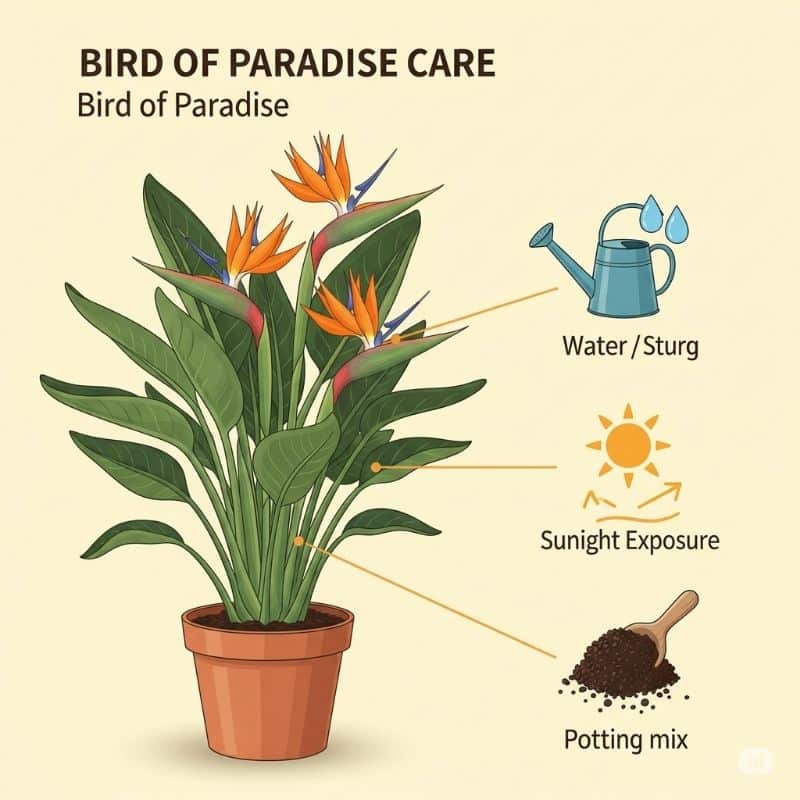
Bird of Paradise Care Summary
Here’s a quick overview of what your Bird of Paradise loves:
| Care Category | What Your Bird of Paradise Needs |
| Light | Plenty of bright, direct sun (at least 6 hours daily for blooms). |
| Watering | Keep the soil consistently moist, allowing the top 1–2 inches to dry out between waterings. Reduce watering during the winter months. |
| Temperature | Warm, 65-80°F (18-27°C); avoid cold drafts. |
| Humidity | Moderate to high; benefits from pebble tray, humidifier, occasional misting. |
| Soil | Well-draining, rich potting mix with drainage holes. |
| Potting | Prefers to be slightly root-bound for flowering; repot infrequently. |
| Feeding | Monthly during spring/summer with diluted balanced liquid fertilizer (higher P/K for blooms). |
The Right Light: Plenty of Bright, Direct Sun for Blooms!
This is the most critical factor if you want to see those stunning “bird” blooms! Your Bird of Paradise needs plenty of bright, direct sunlight – ideally at least 6 hours of direct sun per day. Think of a sunny, south or west-facing window. If it gets less light, the plant might still grow, but it’s unlikely to flower. Less light can also lead to fewer, smaller leaves.
Watering Smart: Consistently Moist, But Not Soggy!
Bird of Paradise plants love consistent moisture during their active growing season. Water thoroughly when the top 1-2 inches (2.5-5 cm) of soil feel dry to the touch. The goal is to keep the soil consistently moist but never soggy! They really dislike having their roots sit in standing water, which can quickly lead to root rot. Make sure your pot has fantastic drainage! During the cooler, slower winter months, you can significantly reduce watering, as the plant’s growth slows down.
Cozy Temperatures and High Humidity, Please!
Much like their tropical origins, Bird of Paradise plants thrive in warm temperatures, ideally between 65–80°F (18–27°C). They are sensitive to cold drafts and sudden temperature drops, so keep them in a snug spot! They also appreciate moderate to high humidity. If your indoor air is dry, especially with winter heating, you might notice crispy leaf edges. To make them feel a bit more at home, you can use a humidifier, place the pot on a pebble tray with water, or occasionally mist their leaves.
Choosing the Right Soil and Pot: Drainage is a Must!
Your Bird of Paradise will be happiest in a well-draining, rich potting mix. A good quality indoor potting mix works great. As with almost all plants, always pick a pot with fantastic drainage holes! These plants actually prefer to be a little bit root-bound when it comes to flowering, so you won’t need to repot them very often – maybe every 2-3 years, or when roots are seriously bursting out. Spring is typically the ideal time to repot Bird of Paradise plants, as it aligns with their active growing season.
Feeding Your Bird of Paradise: Regular Meals for Big Blooms
To fuel all that magnificent growth and encourage those incredible blooms, your Bird of Paradise will appreciate regular feeding during its active growing season (spring and summer). Use a balanced liquid houseplant fertilizer, or one slightly higher in phosphorus and potassium (which helps with flowering), diluted to half strength, about once a month. When fall arrives and winter sets in, you can stop feeding entirely.
What Are Common Problems with Bird of Paradise Plants and How to Fix Them?
Bird of Paradise plants are generally robust, but they will definitely tell you if something’s not quite right. Here’s what to look for:
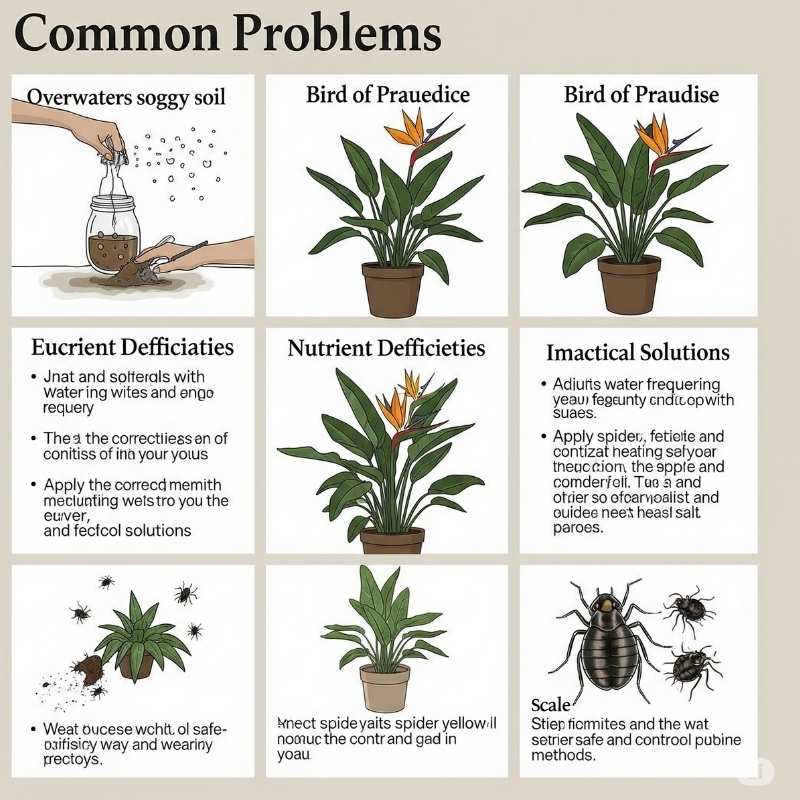
Common Bird of Paradise Problems & Solutions
| Problem | What It Looks Like | Common Cause(s) | How to Fix |
| No Blooms | Plant isn’t flowering | Not enough direct light, immaturity, not root-bound, inconsistent care | Provide 6+ hours direct sun. Be patient. Fertilize correctly. Let it get slightly root-bound. |
| Yellowing Leaves | Leaves turn yellow, often lower ones | Overwatering (most common), root rot, sometimes nutrient deficiency | Let soil dry more; check drainage. Ensure adequate light & fertilizing. |
| Brown/Crispy Edges/Tips | Dry, brittle leaf edges/tips | Underwatering, low humidity, dry air | Water consistently; increase humidity (humidifier/pebble tray). |
| Splitting Leaves | Leaves naturally tear along veins | Perfectly normal! Not a problem. | It’s natural! Helps them withstand wind in nature. |
| Drooping Leaves | Leaves look limp/sad | Underwatering (thirsty) OR overwatering (root rot) | Check soil moisture: if dry, water; if soggy, let dry/check roots. |
| Pests | Tiny webs, sticky residue, small bugs | General plant stress, dry air (spider mites) | Inspect regularly. Treat with insecticidal soap or neem oil. |
| Root Rot | Mushy stems at soil line, foul smell | Persistent overwatering | Prevent with proper watering & drainage. If severe, repot, trim rotten roots. |
Is the Bird of Paradise Plant Toxic? Safety for Pets
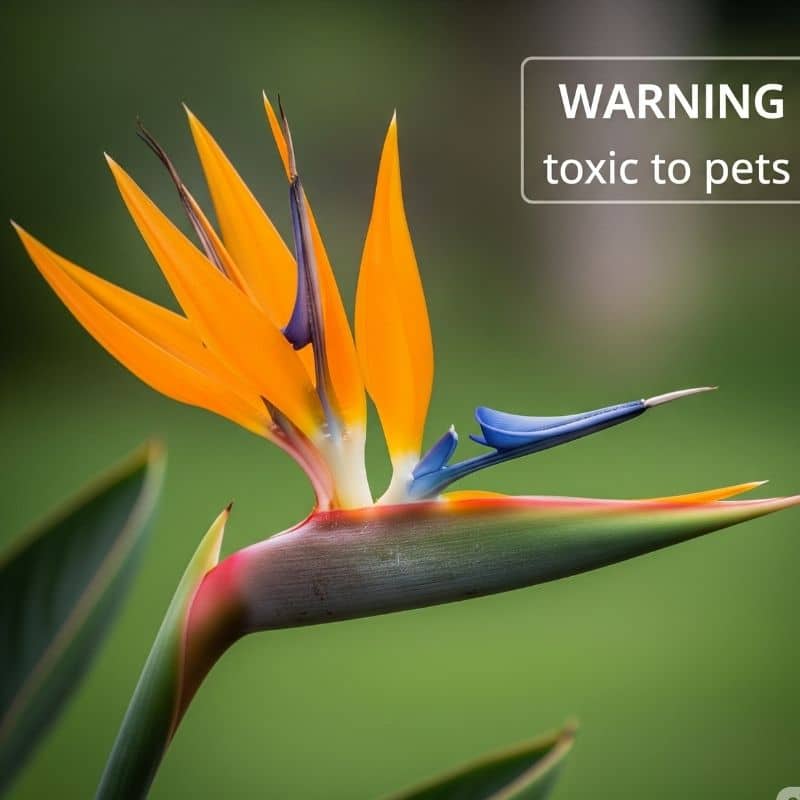
Yes, it’s very important to know: Bird of Paradise plants are considered toxic if ingested. They contain compounds called cyanogenic glycosides, which can be found in various parts of the plant, but especially in the seeds.
If your cats, dogs, or other pets chew on a Bird of Paradise, you might see symptoms like:
- Vomiting and diarrhea: This is the most common immediate response or reaction.
- Lethargy or weakness: The pet may seem unusually tired.
- Drooling.
- In more severe (and rare) cases with significant ingestion, especially of seeds, dizziness or difficulty breathing could occur.
While usually not life-threatening unless a very large amount is eaten, it can cause significant discomfort. So, it’s highly recommended to keep Bird of Paradise plants out of reach of curious pets and small children. If you suspect your pet has ingested any part of a Bird of Paradise and is showing symptoms, contact your veterinarian immediately for guidance.
Bird of Paradise Plant for Home Decor: Tropical Drama and Architectural Flair
The Bird of Paradise plant is a decorator’s dream, bringing both impressive size and sophisticated style to any room:
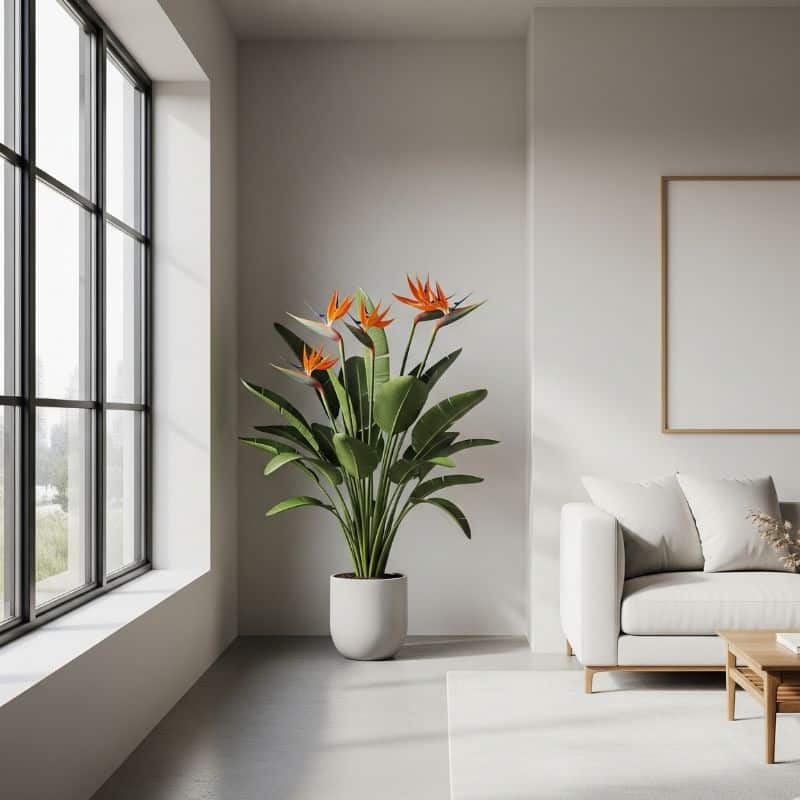
Creating a Bold, Tropical Statement
With its large leaves and unique, vibrant flowers, a Bird of Paradise can instantly become a magnificent focal point in your home. It draws the eye and adds a grand, tropical presence that screams “paradise!”
💡 Great spot for an image! You could include a gorgeous photo of a large Bird of Paradise plant placed as a striking corner accent in a stylish living room, showcasing its bold, tropical elegance. Let me know if you’d like me to help find or create an image for this!
Perfect for Bright, Sunny Rooms
Since it absolutely thrives on bright, direct light, the Bird of Paradise is ideal for those sunny living rooms, conservatories, or south/west-facing rooms where it can truly bask and show off its glory.
Enhancing Vertical Space and Visual Drama
Its tall, upright growth, especially for Strelitzia nicolai, adds fantastic vertical interest to a room. The Bird of Paradise is perfect for filling tall spaces, adding a sense of living drama and lush, tropical elegance to any room.
A Living Piece of Art
Even without blooms, the Bird of Paradise’s large, paddle-like leaves make it a stunning, architectural plant. It’s a living sculpture that brings a sophisticated and exotic touch to any interior design.
The Allure of Bird of Paradise Plants: Majestic, Exotic, and Rewarding
The Bird of Paradise plant truly stands out as a top choice for indoor gardeners who dream of something extraordinary. It offers an unbeatable blend of majestic presence, truly exotic blooms (if you can coax them!), and the rewarding experience of cultivating a plant that looks like a living piece of tropical art. While it asks for quite a bit of light and consistency, the vibrant payoff is absolutely worth it. The Bird of Paradise is a true symbol of paradise, infusing your home with a sense of wonder and unparalleled natural beauty.
Frequently Asked Questions (FAQ) About Bird of Paradise Plants
Still have some questions about your wonderful Bird of Paradise? Here are some common ones that might help you out!
Q1: How long does it take for a Bird of Paradise to bloom indoors?
A1: This requires patience! Indoors, a Bird of Paradise (Strelitzia reginae) typically needs to be mature (around 3-5 years old) and receive ample bright, direct sunlight (6+ hours daily), along with proper care, to bloom. Even then, it’s not guaranteed, but it’s very rewarding when it happens! Strelitzia nicolai is even less likely to bloom indoors due to its larger size.
Q2: How much light does a Bird of Paradise need?
A2: For best growth and especially for blooming, a Bird of Paradise needs plenty of bright, direct sunlight – ideally 6 or more hours of direct sun per day. A south or west-facing window is usually ideal for a Bird of Paradise. Less light can result in slower growth and fewer chances of flowering.
Q3: What’s the difference between Strelitzia reginae and Strelitzia nicolai?
A3: The main differences are size and flower color. Strelitzia reginae (the classic orange Bird of Paradise) is smaller, growing 3-6 ft tall indoors, with orange and blue flowers. Strelitzia nicolai (the White/Giant Bird of Paradise) is much larger, growing 6-15+ ft tall indoors, with bigger, banana-like leaves and white and blue flowers.
Q4: How often should I water my Bird of Paradise?
A4: Water thoroughly when the top 1–2 inches (2.5–5 cm) of soil feel dry to the touch, ensuring the plant stays hydrated without becoming waterlogged. Keep the soil consistently moist during the growing season, but never soggy. Reduce watering significantly in winter.
Q5: Why are my Bird of Paradise leaves splitting?
A5: Don’t worry, splitting leaves are perfectly normal for Bird of Paradise plants! In their natural windy habitats, these splits help the large leaves withstand strong gusts. It’s a natural adaptation and not a sign of poor health.
Q6: Is the Bird of Paradise plant toxic to pets?
A6: Yes, Bird of Paradise plants are toxic if ingested by cats, dogs, and other pets. They contain compounds that may cause symptoms such as vomiting, diarrhea, and lethargy. It’s safest to keep them out of your pet’s reach.
Q7: Can I put my Bird of Paradise outside?
A7: Yes! In warm weather (above 50°F / 10°C), you can place your Bird of Paradise outdoors in a sunny spot (gradually acclimate it to direct sun). Just remember to bring it back indoors before temperatures drop in the fall, as it’s not frost-tolerant.
Q8: Why are my Bird of Paradise leaves turning yellow?
A8: Yellowing leaves, especially lower ones, are most often a sign of overwatering (the soil staying too wet). It can also be caused by insufficient light, cold drafts, or occasionally a nutrient deficiency.
Q9: How tall can a Bird of Paradise get indoors?
A9: The classic Strelitzia reginae can typically reach 3-6 feet (1-2 meters) tall indoors. The Strelitzia nicolai (white variety) is much larger and can grow from 6-15 feet (2-4.5 meters) or even more indoors if given enough space and ideal conditions, making it a true indoor tree.

